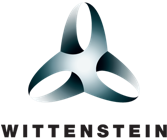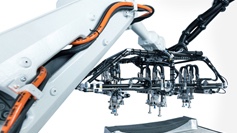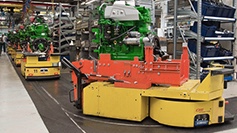Noses to the wind: generators for renewable power conversion
The ability to generate wind power with a rooftop turbine is an exciting new option. The compact ENFLO 0110 wind turbine, which can be installed without a permit, opens up new opportunities for private households and commercial firms to produce their own energy. Built by WindTec Systems, it is not only quiet, reliable, pleasing to the eye and economical but also very efficient. The integrated WITTENSTEIN cyber motor generator is a key component.
WindTec Systems admittedly hasn't reinvented the wheel and the realization that a motor can generate electricity by feeding kinetic energy is not exactly revolutionary. Against this background, it comes as no surprise to learn that permanent magnet synchronous motors like the MRSx series from WITTENSTEIN cyber motor are very much in demand in the wind power sector. They feature not only very quiet running and a space-saving design but also a greatly reduced weight / power ratio (kg / kW) and far higher efficiency than can be achieved with asynchronous technology. "Added to that, WITTENSTEIN has the experience and expertise to design drive solutions for specific applications", says Dirk Süss, Managing Director of WindTec Systems. The ENFLO 0110 wind turbine is thus more than just a simple 'rotor plus motor'. "It was the fine tuning work – both on the rotor and turbine technology and undertaken together with WITTENSTEIN cyber motor during the design and optimization of the generator – that helped make the development of this novel wind turbine such an exciting project", Süss recalls.
WindTec Systems: a wind of change in the renewable energy production market
There's no reason why house roofs should remain the exclusive domain of photovoltaic systems for ever more – WindTec Systems, based in Kreuzlingen (Switzerland), is specialized in the manufacture and distribution of small wind turbines for private individuals, commercial firms and any kind of power consumer at off-grid locations, such as mobile towers on a hill or in an open field. The company is currently the only vendor in the market that is capable of erecting small yet efficient wind turbines on urban sites. Uwe Steffens-Paal, Managing Director of ENFLO Service, explains why: "The ENFLO 0110 wind turbine has a rotor diameter of 1.10 m, making it very compact and also relatively light at around 50 kg. That means it can be mounted easily on a rooftop or a free-standing tower by a plumbing, heating and air conditioning contractor, for example. Planning permission is not required. What's more, the turbine's ingenious construction avoids shadow flicker, reflections, wind and gear noise and the risk of ice throw. Finally, it meets the requirements of wind class 1 and withstands wind speeds of up to 75 m/s."
Energy conversion using robust, industrially proven servo motor technology
The design experts at WindTec Systems invested a great deal of time and effort in maximizing the efficiency of their ENFLO 0110 wind turbines. Thanks to the special geometry of the lightweight, the five-blade rotor and the aerodynamic ducted diffuser, an energy yield several times that of small wind turbines with a free rotor is achieved. "WindTec Systems was on the lookout for a suitable generator solution that would allow the kinetic energy obtained by this complex method to be converted to electricity without any loss of power and decided to get in touch with us", Dieter Bauch-Panetzky, a development engineer at WITTENSTEIN cyber motor, recollects. "We recommended a permanent magnet synchronous servo motor with about 2 kW maximum output as the starting point for the generator. The generator then 'grew' with the wind turbine as the project progressed. It was gradually perfected for this highly specific application, with the result that the generator and the wind turbine are now optimally harmonized in the ENFLO 0110 with an efficiency of up to 98% – a vital precondition in this performance class and this scenario", Steffens-Paal confirms. "Every percentage point less efficiency would have a negative effect on the turbine's payback calculation." Another argument in favour of motors and generators from WITTENSTEIN cyber that is crucial for the success of small turbines is their exceptional ruggedness. "Operators of conventional small wind turbines don't just complain about the noise and poor output; they're also dissatisfied with the short lifespan and high costs for maintenance and repair", Süss adds, speaking from experience. These are issues that neither he nor his customers have to worry about any more: "The rotor and stator are well protected inside the generator and the bearing technology has already demonstrated its suitability in harsh industrial environments. They're virtually maintenance-free and at present there are hardly any restrictions on the service life", Bauch-Panetzky reports. WindTec Systems evidently concords with this view and guarantees a minimum life of twenty-five years for the ENFLO 0110 – not only because of the stability of the design but also owing to the general robustness of the WITTENSTEIN cyber motor components.
WITTENSTEIN AG, the parent company, is similarly optimistic: President Dr. Manfred Wittenstein has already ordered a wind turbine from Dirk Süss and Uwe Steffens-Paal for his Igersheim-Harthausen premises. It will probably be manufactured at WindTec's brand new production facility in Macedonia, which will officially open in May 2012. The production volume there will initially comprise 500 turbines a month, rising to 1000 in a future expansion stage.
WITTENSTEIN generator technology also planned for large wind turbines
The ENFLO 0110, which is sold with increasing success via industrial wholesalers, specialist installers and the electrical industry, and the new Macedonian facility will drive WindTec Systems' future growth. "The 1.5 kW wind turbine with a rotor diameter of 1.10 m for rooftop installation on private homes is only the beginning", Süss predicts. "Turbines with a rotor measuring anything from 2 to 22 m will follow for a broad range of applications." WindTec Systems already has plans to manufacture a two-metre turbine that can generate up to 5 kW. Steffens-Paal: "It will be ideal for the needs of the mobile market, for instance". A three-metre version with a maximum output of 10 kW that is also in the engineering pipeline and expected to be ready for market mid-way through 2012 will be targeted at local authorities, agricultural businesses and industrial firms. Planning permission will be obligatory for this size, however, as it will for the seven-metre 50 kW turbine developed for the electromobility market (charging stations for electric cars).
Bigger turbines need not only bigger rotors but also bigger generators – a challenge that WITTENSTEIN cyber motor is looking forward to facing. "Although the exact specifications of the three-metre turbine, for example, are not yet known", says Dr. Michael Geier, General Manager of WITTENSTEIN cyber motor, "I'm confident that a synchronous generator with a maximum output of 15 kW that can be optimally matched to the larger unit will prove to be a feasible solution. Once again, the chief problem will be to convert the low speeds as efficiently as possible without a gearhead. Our aim will be to maximize the overall efficiency of the system. Our portfolio of servo motors and generators covers the performance range from 0.001 kW to 250 kW, and I'm sure we'll be able to offer WindTec Systems the right generator for every rotor."
This conviction is only logical in view of the fact that WITTENSTEIN cyber motor has already developed numerous generators for wind and hydroelectric power conversion as a strong partner for companies in the renewables market. The Igersheim specialist knows which way the wind is blowing…
Efficient even in low-wind regions
In addition to structural and development aspects, the ENFLO 0110 also complies with operators' high efficiency requirements. "A wind speed of just 2.5 m/s is sufficient to generate electricity – even at night, when photovoltaic systems stop feeding into the house grid and are unable to produce hot water", says Dirk Süss. "With its nominal power of 1 kW and 1.5 kW maximum, it can generate between 2500 and 3000 kWh of electricity a year even in so-called low-wind regions like southern Germany. In the windy north, this figure can be as high as 4500 kWh. Owners of detached houses can not only generate a significant portion of their electricity consumption from a renewable source; they also cut their electricity bill by several hundred euros a year. It only takes a few years to recover the investment in such a small wind turbine, which costs around 6500 to 7000 euros including the tower." Following this initial period, the turbine earns (in other words, saves) considerable hard cash – not least because the WITTENSTEIN cyber motor generator at its heart combines extremely high efficiency with total freedom from maintenance and virtual indestructibility.


